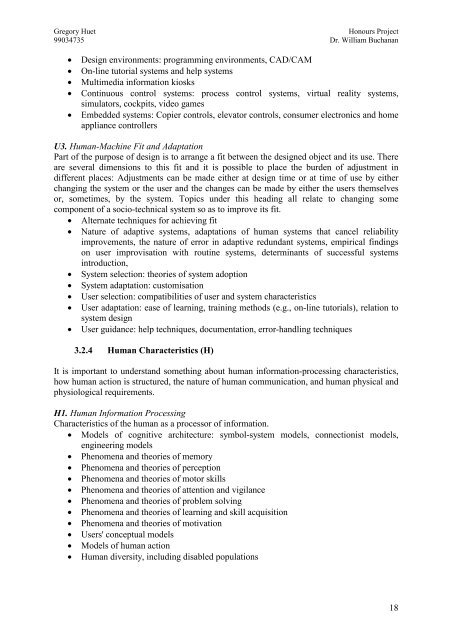Honours Project: - Napier University
Honours Project: - Napier University
Honours Project: - Napier University
Create successful ePaper yourself
Turn your PDF publications into a flip-book with our unique Google optimized e-Paper software.
Gregory Huet<br />
<strong>Honours</strong> <strong>Project</strong><br />
99034735 Dr. William Buchanan<br />
• Design environments: programming environments, CAD/CAM<br />
• On-line tutorial systems and help systems<br />
• Multimedia information kiosks<br />
• Continuous control systems: process control systems, virtual reality systems,<br />
simulators, cockpits, video games<br />
• Embedded systems: Copier controls, elevator controls, consumer electronics and home<br />
appliance controllers<br />
U3. Human-Machine Fit and Adaptation<br />
Part of the purpose of design is to arrange a fit between the designed object and its use. There<br />
are several dimensions to this fit and it is possible to place the burden of adjustment in<br />
different places: Adjustments can be made either at design time or at time of use by either<br />
changing the system or the user and the changes can be made by either the users themselves<br />
or, sometimes, by the system. Topics under this heading all relate to changing some<br />
component of a socio-technical system so as to improve its fit.<br />
• Alternate techniques for achieving fit<br />
• Nature of adaptive systems, adaptations of human systems that cancel reliability<br />
improvements, the nature of error in adaptive redundant systems, empirical findings<br />
on user improvisation with routine systems, determinants of successful systems<br />
introduction,<br />
• System selection: theories of system adoption<br />
• System adaptation: customisation<br />
• User selection: compatibilities of user and system characteristics<br />
• User adaptation: ease of learning, training methods (e.g., on-line tutorials), relation to<br />
system design<br />
• User guidance: help techniques, documentation, error-handling techniques<br />
3.2.4 Human Characteristics (H)<br />
It is important to understand something about human information-processing characteristics,<br />
how human action is structured, the nature of human communication, and human physical and<br />
physiological requirements.<br />
H1. Human Information Processing<br />
Characteristics of the human as a processor of information.<br />
• Models of cognitive architecture: symbol-system models, connectionist models,<br />
engineering models<br />
• Phenomena and theories of memory<br />
• Phenomena and theories of perception<br />
• Phenomena and theories of motor skills<br />
• Phenomena and theories of attention and vigilance<br />
• Phenomena and theories of problem solving<br />
• Phenomena and theories of learning and skill acquisition<br />
• Phenomena and theories of motivation<br />
• Users' conceptual models<br />
• Models of human action<br />
• Human diversity, including disabled populations<br />
18










![Unit 5. Switches and VLANs [PDF]](https://img.yumpu.com/34422504/1/184x260/unit-5-switches-and-vlans-pdf.jpg?quality=85)





